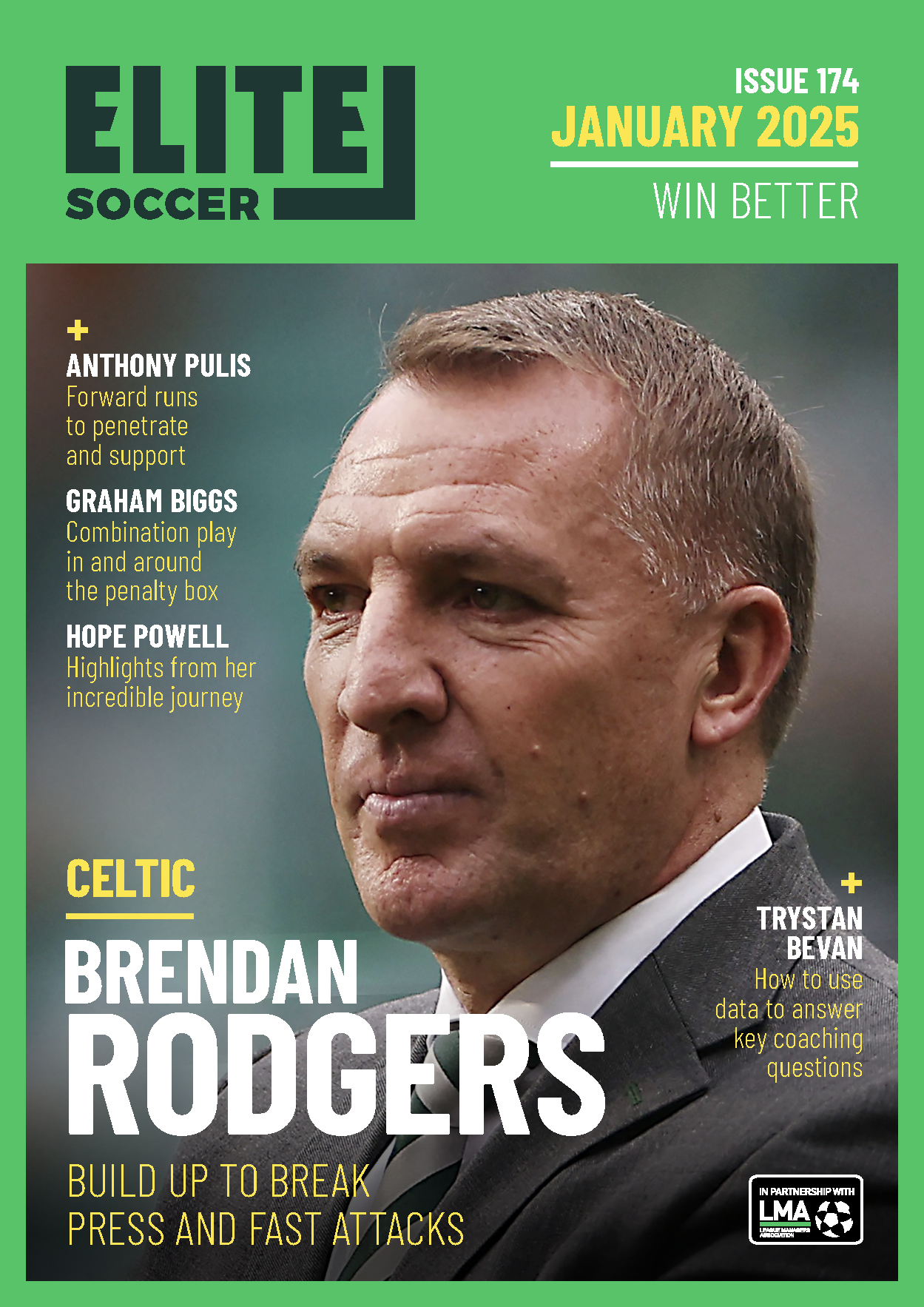You are viewing 1 of your 1 free articles
Counter-attacking on transitions
This session focuses on the transitional moment of regaining possession of the ball.
| Area | Initially 50x44 yards and then full pitch |
| Equipment | Balls, bibs, cones, 3 full size goals |
| No. of Players | 20 players + 3 goalkeepers |
| Session Time | Wave game: 24mins Changing ends: 30mins 11v11 game: 15mins |
This session focuses on the transitional moment of regaining possession of the ball. It begins by providing players with repetitions of overload opportunities that increase in both complexity and difficulty. As the session evolves, players are challenged using tactical scenarios and then asked to evaluate live game situations.
The three practices that make up this session all keep the players fully engaged, as opportunities to attack, defend and score are readily available.
Engagement can be increased by keeping score in all three practices. The challenge across the session develops from small group play into tactical scenarios and then into live 11v11 play to scaffold the learning for the players.
The theme is attacking quickly on regains to exploit the opposition being out of balance. This is a major opportunity to score, if the space can be exploited before the opposition can recover the ball or regain their defensive structure.
This is a game model session and I use it to consistently repeat the principles of how I would like the team to attack on regaining possession and therefore it would be something I would revisit on a timely basis, depending on the number of practice days available between games. It is also a session that I would plan to use more deliberately in the days leading up to a game where counter-attacking has been identified as a critical factor against an upcoming opponent.
Similarly, if I feel that the upcoming game will challenge our defensive transition capabilities I can use this exact same session to reinforce our loss of possession principles. In both game preparation scenarios, the tactical structure of the opponent can be set up to replicate the upcoming challenge. backs”
WAVE GAME
We set up a playing area of 50x44 yards with a halfway line marked with cones and a full-size goal and goalkeeper positioned at each end.
We’re using 20 outfield players split into two teams of ten. Each team stands beside their goal with a good supply of footballs. The blue team begins the game: one player attacks with a ball and finishes against the opposition goalkeeper. Two red players then enter the playing area with a ball and attack the opposite end and the blue who just finished defends against them, making it a 2v1 attack in favour of the reds, as shown [1a].
[1a]
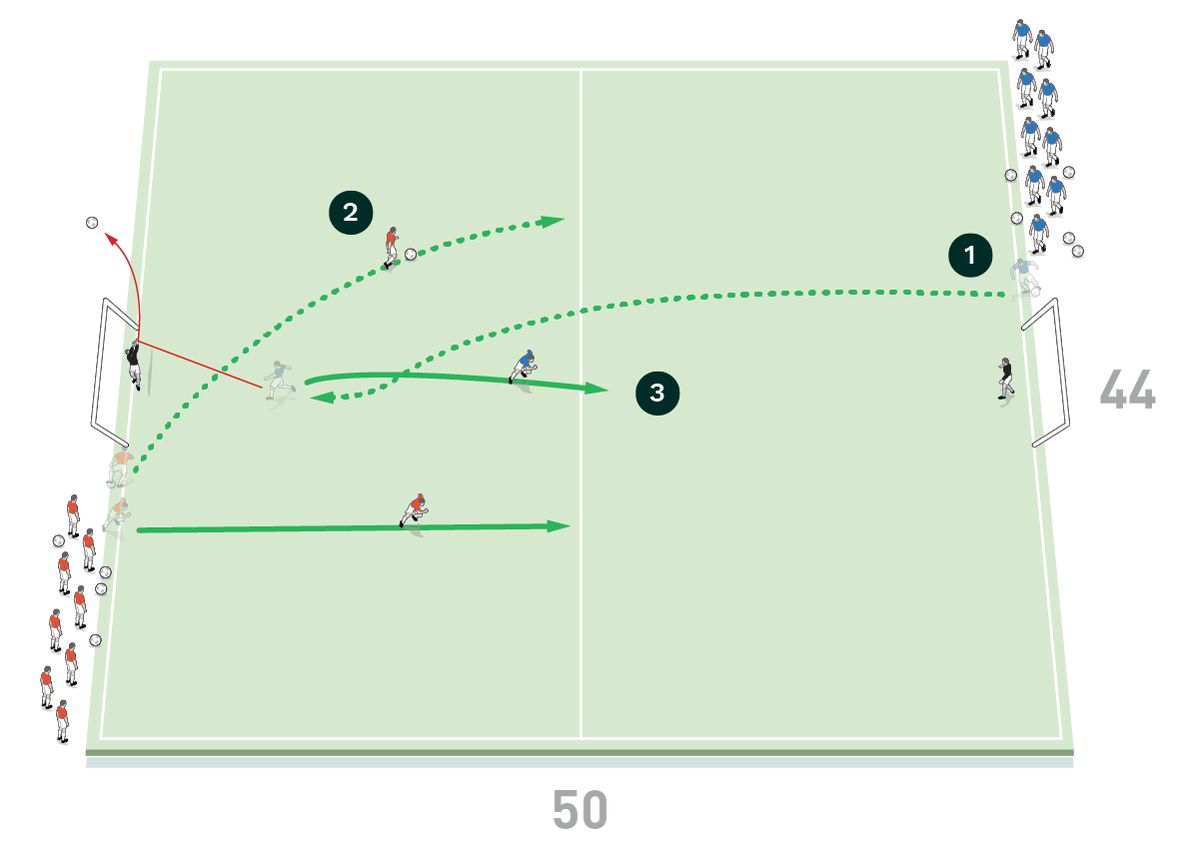
- The blue team begins the game: one player attacks with a ball and finishes against the opposition goalkeeper
- Once the blue attack is dead, two red players enter the playing area with a ball and attack the blue team’s goal
- The blue who took part in the first attack, recovers to defend against the reds, making it a 2v1 in favour of the reds
Once the move has been completed and the attack is dead, two more blue players join the play, making it a 3v2 attack on the goal that the reds are defending. Once this attack has been completed, two more red players join in, making it a 4v3 attack in favour of the reds, as shown [1b].
[1b]
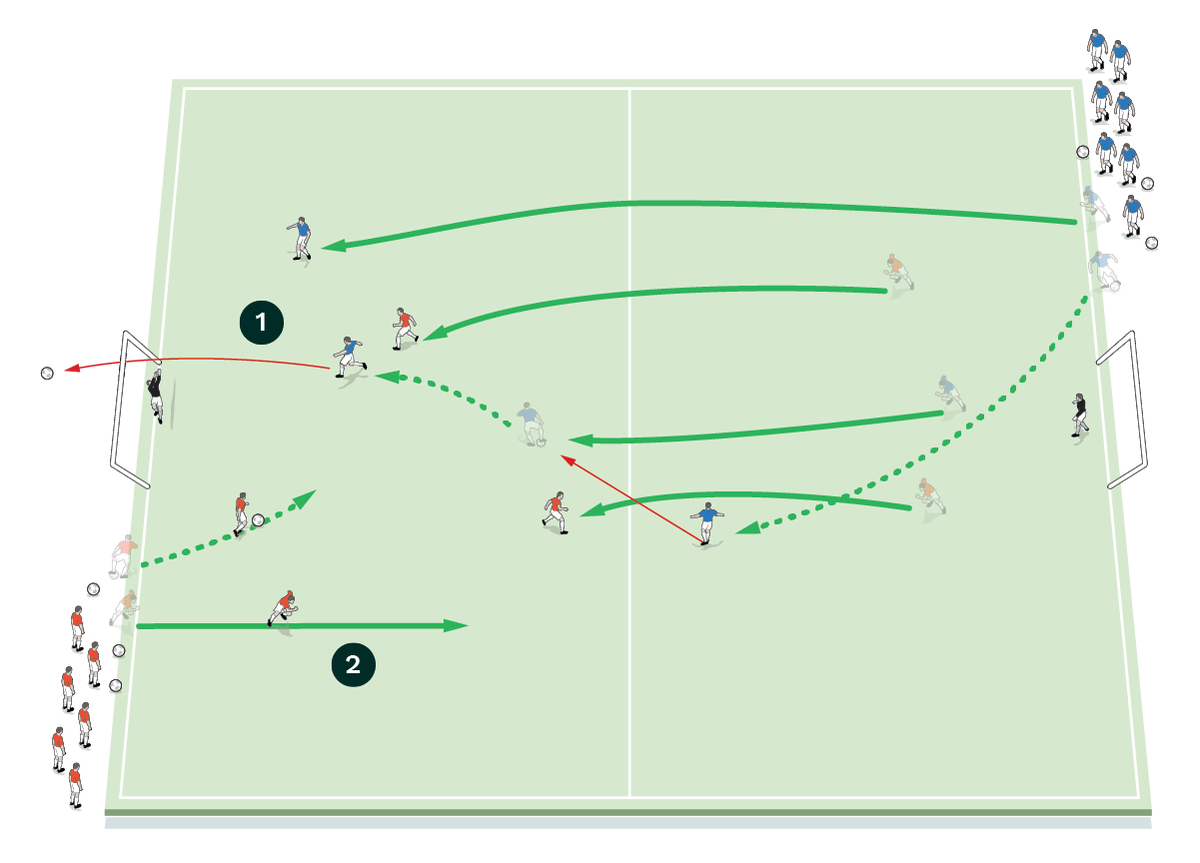
- Once the second attack has been completed, two more blue players join the play, making it a 3v2 attack on the goal that the reds are defending
- Once the third attack is dead, two more red players join in, making it a 4v3 attack in favour of the reds
The game carries on in waves in this fashion until all of the players are on the pitch. The players then play free play in an 11v11 for a set amount of time, as shown [1c].
[1c]
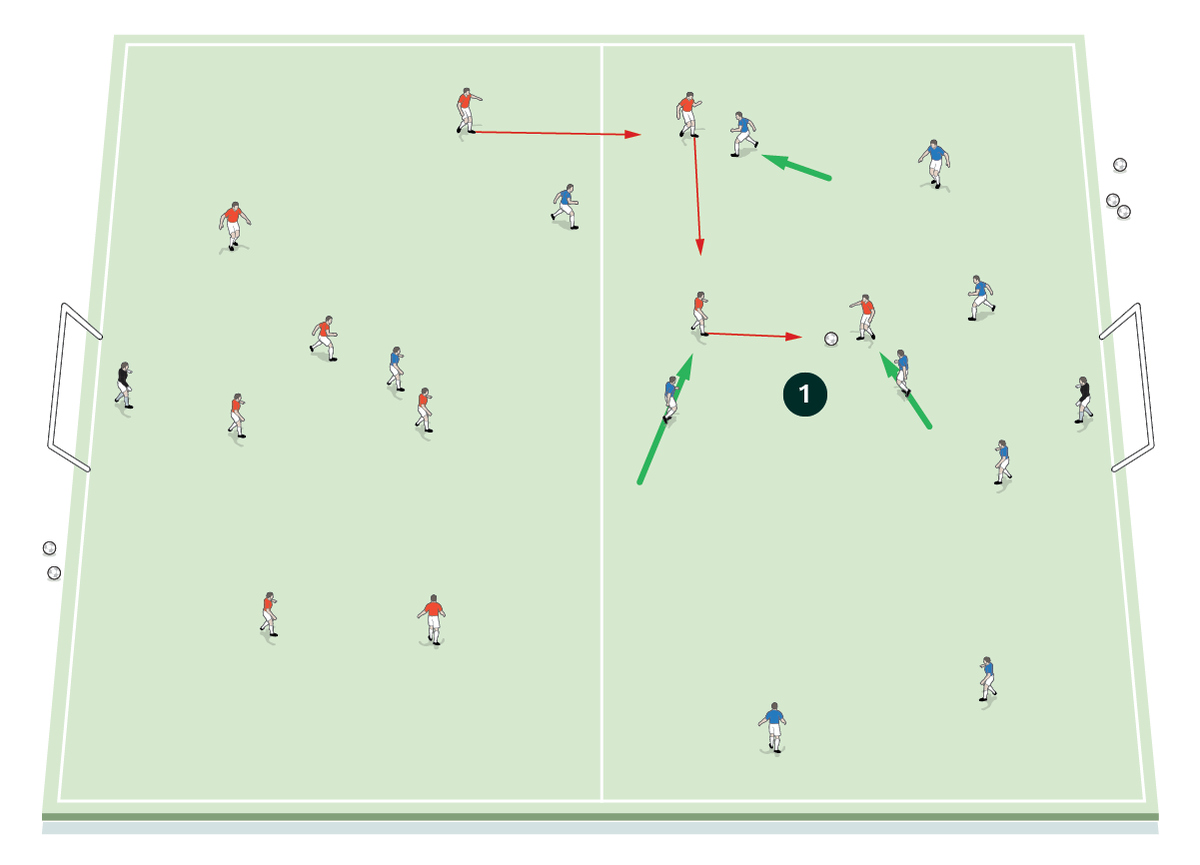
- The game carries on in waves until all the players are on the pitch. The players then take part in free play in an 11v11 for a set amount of time
The game then resets and we repeat, with the reds starting play this time with one red attacking the blue goal. This practice requires repetition of the waves of attack and therefore I would typically look to repeat it either six or eight times with each repetition lasting two to three minutes.
CHANGING ENDS
We set up a pitch with a full-size goal and goalkeeper positioned at each end and a third full-size goal and goalkeeper positioned on the halfway line, as shown. There is a good supply of footballs in the middle goal, in the goal facing it and around the perimeter of that half of the pitch.
We’re using 20 outfield players and three goalkeepers. Two teams of 11 are set up in tactical structures as required by the coach – in this case both teams are set up in a 4-5-1 with a central defensive midfielder.
At the beginning of each game, the coach decides which players from either team can take part in the first attack. The coach begins the practice by serving into the attacking team from beside the goal on the halfway line. In this instance the reds start as the attacking team and the coach has selected six red players to face four blue players in the active half of the pitch. From the start, the reds have eight seconds to score, as shown [2a].
[2a]
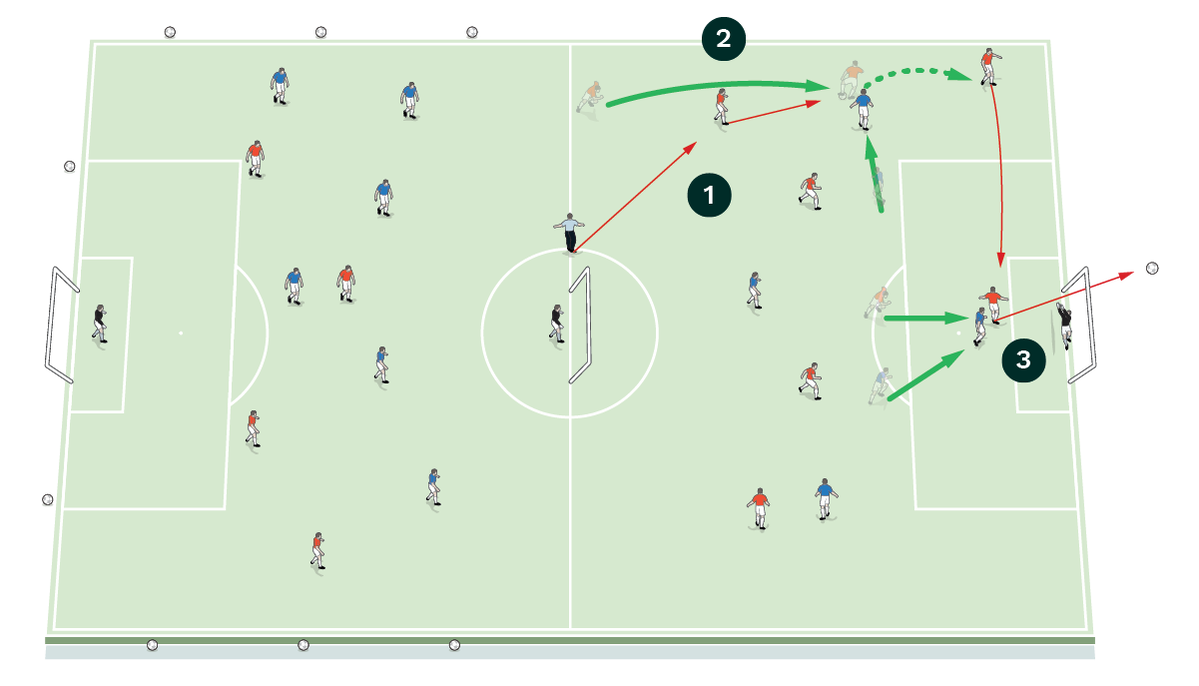
- At the beginning of each game, the coach decides how many players from each team can
take part in the first attack. The coach starts by serving into the attacking team in one half - In this instance the reds start as the attacking team and the coach has selected six reds to face four blues in the active half of the pitch
“At the beginning of each game, the coach decides which players from either team can take part in the first attack”
Once a goal has been scored, the ball has gone dead, or the eight seconds have run out in the first attack, the coach serves a ball into the other half of the pitch for the blue team to attack with a 6v4 advantage against the reds, as shown [2b].
[2b]
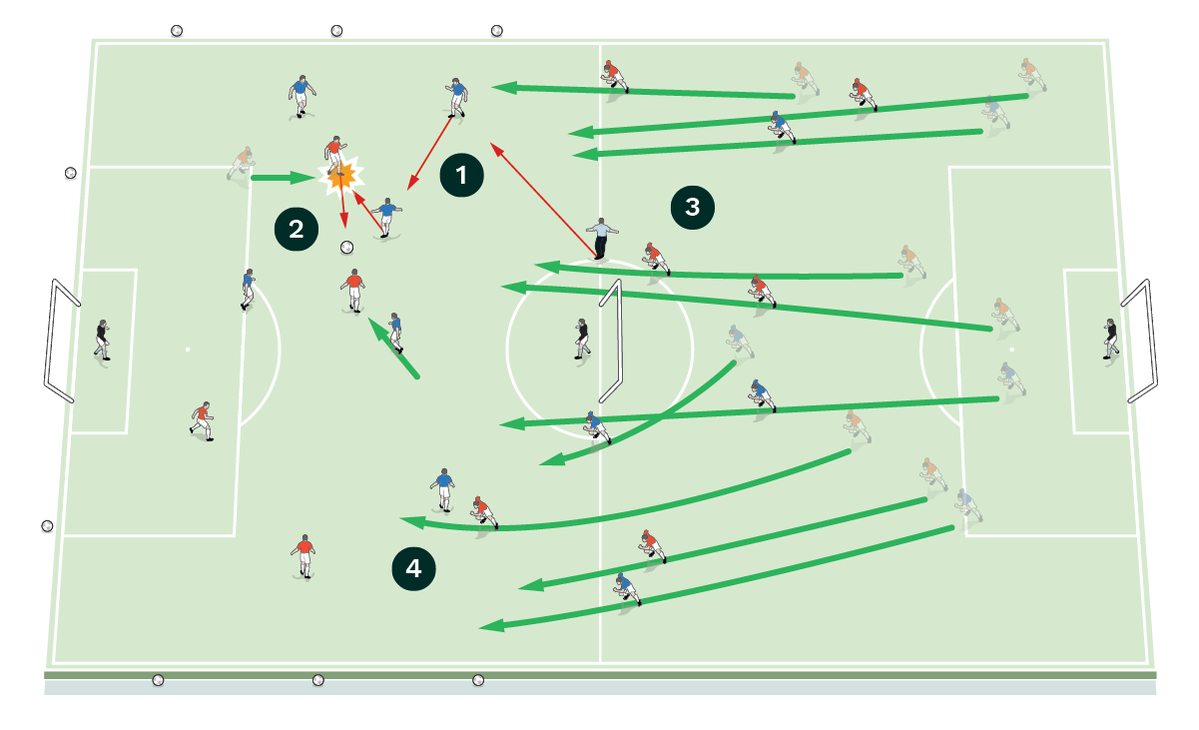
- Once a goal has been scored in the first attack, or the ball has gone dead, or the eight seconds have run out, the coach then serves a ball into the other half of the pitch for the blue team to attack with a 6v4 advantage in that half
- Here the red defending team wins possession from the blues and must counter-attack the goal on the halfway line
- All players from the first attack recover to join in with the new ball in the opposite half as quickly as possible.
- There is no time limit on this attack due to recovering players
If the red team wins the ball, they should counter-attack the goal on the halfway line, while all the outfield players can recover from the first attack to join their team mates in contesting an 11v11 in the active half, as shown [2c].
[2c]
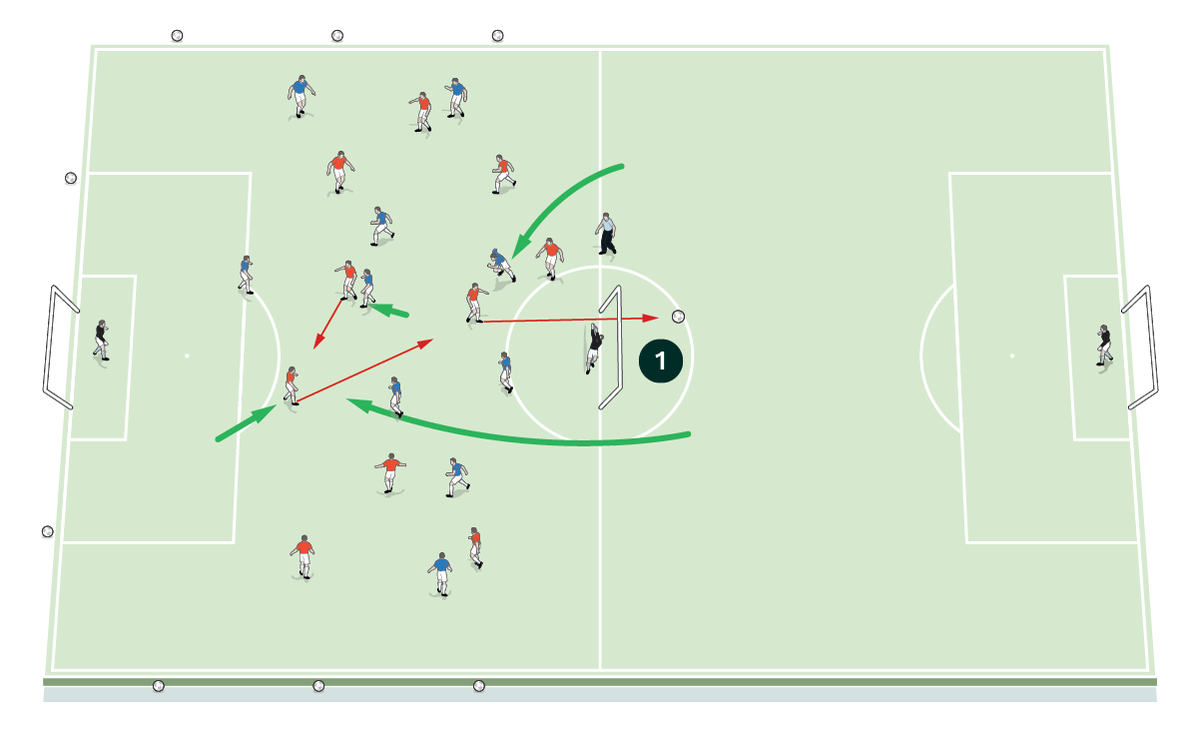
- The reds try to counter-attack the goal on halfway line, while the blues defend 11v11 in the active half
The blues should try to stop the reds from scoring but there is no time limit on this attack. After two minutes of 11v11 free play, the game is reset and the starting team is changed.
In this practice, the coach can experiment and challenge players with different structures and can change the way players are added and removed from each half, and from which positions – for example, it could be a 5v3 in one half and a 7v5 in the other half. This is where the coach can also link in the next game preparation using specific examples.
I would ensure at least eight repetitions of this practice, with each rep lasting two to four minutes.
11v11 GAME
We set up on a full pitch with a full-size goal and a goalkeeper positioned at each end. We’re using two full teams of 11 with formations designated by the coach.
In order to challenge their understanding, at the beginning of the practice the players are tasked with identifying the overload moments they have experienced in the session so far.
Furthermore, it is explained to the players that during the period of play both teams will be allocated three manufactured counter-attacks by the coach. These can occur at any time – the coach will blow a whistle and drop a new ball into play and at this moment players should disregard the first ball and begin play with the new ball, as shown [3].
[3]
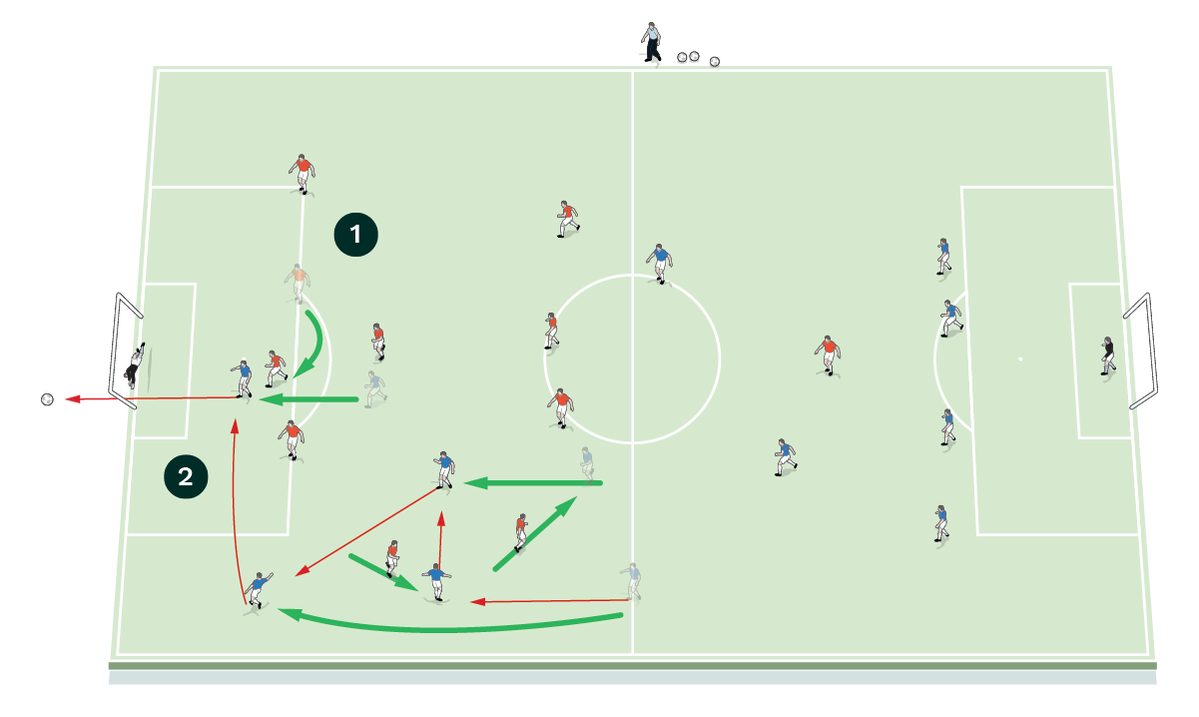
- The two teams play an 11v11 game and try to incorporate what they learnt from the first two practices
- Here the blue team identify a 3v2 overload on the left wing and quickly use it to work a ball into the box to score a goal
COACHING POINTS
What are the key things to look out for?
Throughout the three practices players are asked to:
- Have a positive mindset on all regains – can they pass or run the ball forwards?
- Have an awareness of space available in attack and where there may be an overload. When do they go alone and when do they use team-mates?
- Make runs off the ball to exploit space, which in turn may create an alternative space for a team mate or the player in possession to travel into. The aim is to make complimentary movements.
- Seize the initiative and be decisive – how might they eliminate opponents from the game?
- Recognise when and where the chance to counter-attack ends, and when, where and how possession can be retained to build an attack.
What are the typical mistakes players might make and how do I avoid them?
Speed is key to successful counter-attacking and players will need support with one of two things – either they will be rushed with decisions or they will be too hesitant to make a decision. In both instances possession is likely to be lost.
Ensuring players counter-attack with speed and composure is essential to team success. Players can often rush or delay decisions which hinder the counter-attack. From a technical perspective players should look to run and pass to spaces to maintain the momentum of the attack. Where such passes are not available, can a forward pass to feet be used to set up a future pass to space or the ball be run forwards? Those making runs off the ball have a tendency to attack the same spaces - try to ensure players keep all three “lanes” occupied – left, centre and right as per basketball.
Related Files
Editor's Picks
Using the goalkeeper in build-up play
Pressing principles
Intensive boxes drill with goals
Penetrating the final third
Creating and finishing
My philosophy
Pressing initiation
Compact team movement
Defensive organisation
Coaches' Testimonials

Alan Pardew

Arsène Wenger

Brendan Rodgers

Carlos Carvalhal

José Mourinho

Jürgen Klopp

Pep Guardiola

Roy Hodgson

Sir Alex Ferguson

Steven Gerrard
Coaches' Testimonials

Gerald Kearney, Downtown Las Vegas Soccer Club

Paul Butler, Florida, USA

Rick Shields, Springboro, USA

Tony Green, Pierrefonds Titans, Quebec, Canada
Join the world's leading coaches and managers and discover for yourself one of the best kept secrets in coaching. No other training tool on the planet is written or read by the calibre of names you’ll find in Elite Soccer.
In a recent survey 92% of subscribers said Elite Soccer makes them more confident, 89% said it makes them a more effective coach and 91% said it makes them more inspired.
Get Monthly Inspiration
All the latest techniques and approaches
Since 2010 Elite Soccer has given subscribers exclusive insight into the training ground practices of the world’s best coaches. Published in partnership with the League Managers Association we have unparalleled access to the leading lights in the English leagues, as well as a host of international managers.
Elite Soccer exclusively features sessions written by the coaches themselves. There are no observed sessions and no sessions “in the style of”, just first-hand advice delivered direct to you from the coach.



